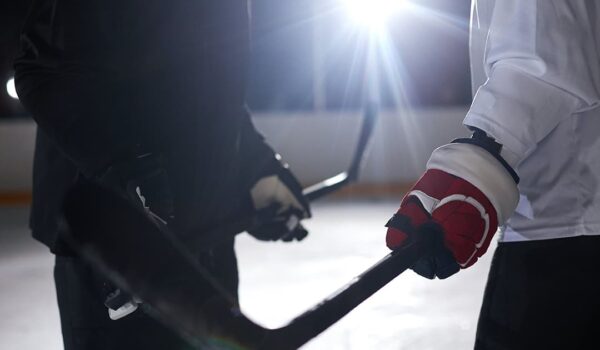Hockey as a form of team sports on ice has existed since time immemorial among many northern peoples long before the advent of skates. Historians claim that Peter the Great himself was a fan of playing with sticks on ice, and even brought iron skates from Holland.
In an organized form close to the modern one, ice hockey was formed at the end of the 19th century. Initially, it was ball hockey. In 1891, the National Bandy Association (as the game is called in Europe) was created in Great Britain, which developed the official rules of the game. Initially, bandy was a kind of winter training for football teams, but later it developed into an independent sport.
Ball hockey
Court
Rectangular, measuring 90-110 meters in length and 45-65 meters in width. The markings are simple, applied in one color. The center line divides the court in half, and the center throw-in point is marked on it. The goal is surrounded by a 17-meter penalty line with two more throw-in points.
Goal
Located in the center of the short sides of the court in line with it. There is no playing field behind the goal. Gate dimensions: 2.10 m in height and 3.50 m in width. In addition to the main net, a so-called damping net hangs inside the gate. The gates must be stable but movable, it is forbidden to “freeze” them into ice.
Equipment
Rubber ball with a diameter of 63 mm and weighing 60 grams.
The stick has a curved “hook”, the outer length of the hook is no more than 125 cm, width 6.5 cm. The weight of the stick is about 450 grams.
Teams
There are 10 players on the field with sticks and one player in goal without a stick – the goalkeeper. Players are divided into defenders, midfielders and forwards. The goalkeeper has the right to play with his hands within the penalty area. The goalkeeper’s gloves are protective, but the fingers are separate and without membranes. Field players are not allowed to play with their hands.
Ice hockey
The ancestors of this sport are Canadians. The first professional hockey team was created in Canada in 1904, and the famous NHL National Hockey League appeared in 1917. At the same time, rules and conditions were developed, which have changed little since then.
Rink
The NHL rules prescribe a court size of 200×85 feet, i.e. 60.96 x 25.90 meters. In the International Ice Hockey Federation (IIHF), the width of the rink is slightly larger: 29-30 meters, and the length is the same – 60-61 meters. The corners of the court must be rounded with a circle arc with a radius of 7 m to 8.5 m according to IIHF rules and strictly 8.5 m in the NHL. The court must have strong sides with a height of 1-1.22 meters. In the center of the wide sides there are gates (with the doors facing inward) for players to enter the field. On the opposite side there are similar gates for (and benches for) penalized players. Behind the gates, there must be transparent fences from 1.6 to 2 meters high to prevent the puck from flying to the spectators.
Markings
The central red line divides the court in half. In the middle of this line is the central throw-in point with a red circle of 4.5 meters in diameter, marking the throw-in zone, behind which players who do not play the puck must be located. The goal lines are drawn 3-4 meters from the boards, 17, 23 meters from the goal lines. Blue lines are drawn that divide the court into three zones – the central zone and 2 team zones. There are two more throw-in points 6 meters from the goal on both sides.
Gate
Width 1.83 m, height 1.22 m. The net protrudes 0.8-1 meter beyond the goal. The diameter of the posts is 5 cm. The size of the goal area is determined by a radius of 1.8 meters. The gates are installed on the pins so that they can “pop out” of the grooves in the ice to avoid injuries to players in case of a strong impact.
Equipment
An ice hockey stick is a stick with a flat hook at the end. The rules allow different sizes of sticks for players, according to their individual characteristics, the usual sizes are 150-200 cm. The hook is located at an angle of 135 ° to the stem, the length of the hook is 25-40 cm. The hook allows a slight bend to the side, convenient for the player. The puck is a solid cylinder with a height of 2.54 cm, a diameter of 7.62 cm, and a weight of 156-170 g.
Teams
There are 6 players on the field – 1 goalkeeper, 2 defenders and 3 forwards. Players can be replaced both during breaks and during the game. It is allowed to replace the goalkeeper with a field player.
